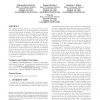Free Online Productivity Tools
i2Speak
i2Symbol
i2OCR
iTex2Img
iWeb2Print
iWeb2Shot
i2Type
iPdf2Split
iPdf2Merge
i2Bopomofo
i2Arabic
i2Style
i2Image
i2PDF
iLatex2Rtf
Sci2ools
ICDE
2008
IEEE
2008
IEEE
Link Privacy in Social Networks
We consider a privacy threat to a social network in which the goal of an attacker is to obtain knowledge of a significant fraction of the links in the network. We formalize the typical social network interface and the information about links that it provides to its users in terms of lookahead. We consider a particular threat where an attacker subverts user accounts to get information about local neighborhoods in the network and pieces them together in order to get a global picture. We analyze, both experimentally and theoretically, the number of user accounts an attacker would need to subvert for a successful attack, as a function of his strategy for choosing users whose accounts to subvert and a function of lookahead provided by the network. We conclude that such an attack is feasible in practice, and thus any social network that wishes to protect the link privacy of its users should take great care in choosing the lookahead of its interface, limiting it to 1 or 2, whenever possible....
| Added | 01 Nov 2009 |
| Updated | 01 Nov 2009 |
| Type | Conference |
| Year | 2008 |
| Where | ICDE |
| Authors | Aleksandra Korolova, Rajeev Motwani, Shubha U. Nabar, Ying Xu 0002 |
Comments (0)

